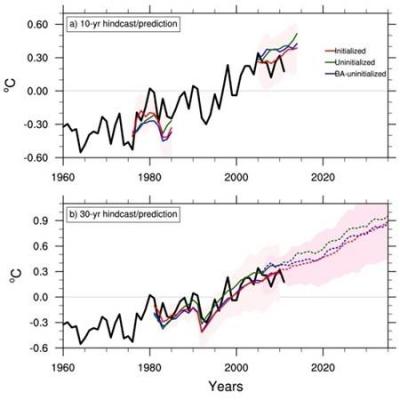Lower Estimates of Near-term Global Warming from Initialized Climate Models
Due to the slowing of global warming after about 2000, the so-called “early-2000s hiatus”, there have been criticisms that climate models are not able to simulate the hiatus, and models in general simulate warming greater than what has been observed and would therefore likely inflate future projections of global warming. Indeed, an average of all climate models run with only changes in external forcings, such as changes in greenhouse gases and solar variability, simulate greater warming than observed for the early 2000s. But a subset of those same climate models initialized with observations at the beginning of the hiatus show that the warming slow-down is simulated. A previous period in the late-1970s when there was a rapid increase of warming can also be simulated using the relatively new technique of initialized decadal climate prediction with 16 climate models. A 30 year prediction from the initialized multi-model simulations show about 16% less global warming for the 2016-2035 period than the uninitialized free-running model projections for that same time. One contributing factor for the reduced future warming is the bias adjustment, which corrects the models’ systematic errors and higher-than-observed decadal warming trend. Another factor is the constraint of the ocean conditions through initialization with observations. Thus, climate models that utilize the new methodology of initialized decadal climate prediction show increased capability in simulating past climate shifts, the early-2000s hiatus, and a reduced amplitude of near-term global warming compared to the traditional uninitialized climate model projections.

